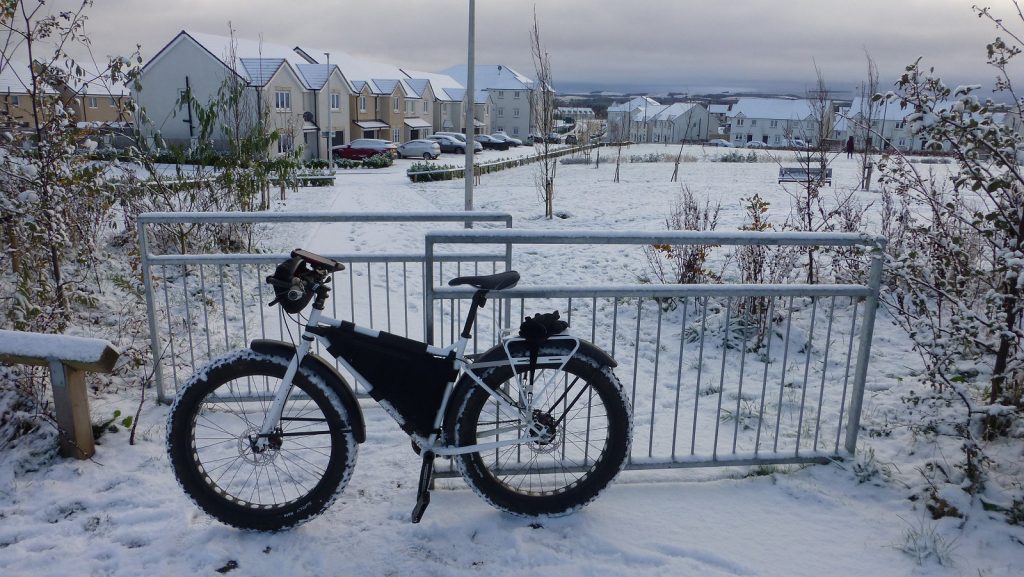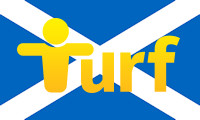Having been cooped up in the house all day keeping an eye on the builders who are working on our new and ridiculously expensive mini-porch, I was very keen, nay desperate, to be out on the Surly Ogre taking some zones. And my thanks to all the local turfers who have been busy taking them, mostly Hodge, but also Aibo, MuttsCycles and my wife ChoccyMuffin. And no, winter is not here, yet. I just like using that picture.
My thoughts this evening as I merrily cycled around Bonnyrigg in the cold misty drizzle were on the subject of survival, particularly bicycle turfing in urban areas. Years ago, I was a member of the IAM, the Institute of Advanced Motorists, and more recently, the Institute of Advanced Motorcyclists, and while I never sat the final test (something I regret), I still put the skills learned to good effect, even when out cycling or kick scooting.
The first thing I would look at is how you perceive other road users. I personally treat each and every vehicle, be it another cyclist, car, bus, lorry or even a Hell’s Granny on a mobility scooter as hostile. Imagine each vehicle is driven by a Terminator, not a Turfinator, a real flesh, blood and hyper-alloy combat chassis Terminator. And furthermore, your name is actually Sarah Conner and that the Terminator’s one and only mission is to find you. Treat all vehicles you encounter as potentially a risk until you determine for yourself that they are otherwise. If you always expect the unexpected you can usually do something about it before you come to harm.
Next topic I would look at is visibility. You want to be seen, conspicuous and safe. I was once driving across the Meadows in Edinburgh and came within a millisecond of crashing into a cyclist. It was dark, the cyclist had no lights, his bicycle was black, his clothing was black and he was black as well. The van behind him was also dark coloured and it was only by chance that he crossed the headlights of the van and I noticed him in time. An extreme example but does show the need to be seen to be safe. It may also have been raining at the time.
So, bright clothing is a must and colours such as yellow have been proven to be the most noticeable. I read a report a few years ago, one commissioned by one of the police forces and it showed that fluorescent yellow was proven to be the most conspicuous colour and was adopted as the standard livery for the police across the UK. The fluorescent blue was also included for corporate reasons.
In addition, I would always advocate a good set of lights, one’s you can use as DRL’s or Daytime Running Lights, during the day. Always buy the best you can afford and don’t skimp. I know someone who has spent upwards of £6000 on a bicycle but refused to spend more than £30 on a set of lights. You really do get what you pay for. I would strongly recommend two front lights and two rear lights. Lights can fail, fall off the bike and batteries often go flat and at least if you have two you will always have some lighting.
Another part of being conspicuous is where you position yourself on the road. Always place yourself where you can be seen, don’t hog the gutter, claim your space on the road and be positive, not meek and timid. Make your intentions loud and clear. Remember you have as much right to use the road as anyone else. But do be courteous, don’t be aggressive and don’t be an idiot.
Motorcyclists use something called the life saver. Essentially, when you are moving into another position on the road, you check over your shoulder that nothing else is about to enter that same space. For example, when turning right, a vehicle may be about to overtake you. Even when turning left, some idiot cyclist might be coming up on your left. It really is a life saver and I can recall quite a few occasions when it literally saved my life.
The next topic I want to look at is planning ahead and while it’s a huge subject matter, it can be broken down into three simply parts. And if you keep these in mind you shouldn’t go wrong. The three parts are
- planning for what you can see.
- planning for what you cannot see.
- planning for what you can reasonably expect to happen.
With what you can see, a good example is a car waiting at a junction ahead of you. It’s likely to do two things, pull out in front of you or stay where it is and do nothing. So, keep an eye on that car and expect it to pull out. In another example you might be following a taxi cab. And as it’s a taxi cab anything might happen, so be aware.
With what you cannot see, I’m referring to, for example, what might be around a corner or about to appear from hidden around that corner. There could be anything around that corner that you cannot see. A good example at this time of year is a pile of wet leaves that might have you on the ground in short order, particularly on a bend. So, just think when you are entering an area that you cannot see. Never assume everything is going to be fine.
With what you can reasonably expect to happen, some thought might be required. For example, if following a bus, the bus is likely to stop. If a dog is on one side of the path and the owner on the other, the dog will probably cross to the owner. There are many other examples and it can be fun looking ahead and trying to guess what will actually happen.
So, there we are. A few simply ideas, hints and tips, on staying safe while bicycle turfing. Above all be observant, expect the unexpected, be courteous and polite and stay safe. Back again soon.
Copyright ©2022 Gary Buckham. All rights reserved.


